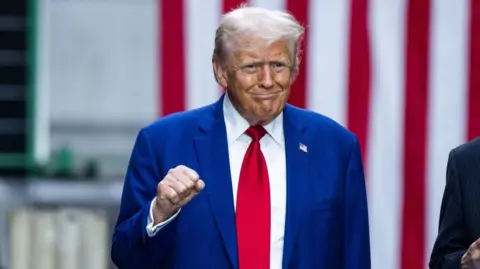
 EPA
EPADonald Trump has promised big changes for the world’s largest economy.
An “end to the devastating inflation crisis”, tariffs and big cuts to taxes, regulation and the size of government are all on the agenda.
This combination, he says, will ignite an economic boom and revive withering faith in the American dream.
“We’re at the beginning of a great, beautiful golden age of business,” he pledged from the podium at Mar-a-Lago earlier this month.
But looming over the president-elect are warnings that many of his policies are more likely to hurt the economy than help it.
And as he prepares to set his plans in motion, analysts say he is about to run into political and economic realities that will make it hard to deliver all his promises.
“There’s no clear path forward at this time for how to meet all these goals because they’re inherently contradictory,” said Romina Boccia, director of budget and entitlement policy at the Cato Institute.
Here’s a closer look at his key promises.
Tackling inflation
What Trump promised:
“Prices will come down”, he said repeatedly.
It was a risky pledge – prices rarely fall, unless there is an economic crisis.
Inflation, which measures not price levels but the rate of price increases, has already come down significantly, while proving tough to stamp out completely.
What complicates it:
Trump pinned his claim to promises to expand already-record US oil and gas production, reducing energy costs. But the forces that affect inflation, and energy prices, are mostly outside presidential control.
To the extent that White House policies make a difference, analysts have warned that many of Trump’s ideas – including tax cuts, tariffs and migrant deportations – risk making the problem worse.
Economist John Cochrane of the right-leaning Hoover Institution said the big question facing the economy is how Trump will juggle “tension” between the more traditional pro-business parts of his coalition and the “nationalists” who are focused on issues such as border control and rivalry with China.
“Clearly both camps can’t get what they want,” he said. “That’s going to be the fundamental story and that’s why we don’t know what’s going to happen.”


What Trump voters want:
Inflation promises were key to Trump’s victory but by many measures, such as growth and job creation, the economy overall was not in the dire straits he painted on the campaign trail.
Since his win, he has tried to lower expectations, warning it would be “very hard” to bring down prices.
Amanda Sue Mathis, 34, of Michigan, says she thinks Trump’s promises are feasible but could take time.
“If anybody can make better deals to make things more affordable for Americans, it’s Donald Trump,” she said. “He literally wrote the book on the art of deal making.”

 Amanda Sue Mathis
Amanda Sue MathisImposing blanket tariffs
What Trump promised:
Trump’s most unorthodox economic promise was his vow to place tariffs – a border tax – of at least 10% on all goods coming into the US, which would rise to more than 60% for products from China.
He has since ramped up the threats against specific countries, including allies such as Canada, Mexico and Denmark.
Some of Trump’s advisers have suggested the tariffs are negotiating tools for other issues, like border security, and he will ultimately settle for a more targeted, or gradual approach.
What complicates it:
The debate has raised speculation about how aggressive Trump will decide to be, given the potential economic risks.
Analysts say tariffs are likely to lead to higher prices for Americans and pain for companies hit by foreign retaliation.
And unlike Trump’s first term, any measures will arrive at a delicate moment, as the long-running US economic expansion appears to be in its final stages.
Even if the toughest tariffs never materialise, the policy debate alone is generating uncertainty that could depress investment and reduce growth in the US by as much as 0.6% by mid-2025, according to Oxford Economics.
“They’ve got a very limited margin for error,” Michael Cembalest, the chairman of market and investment strategy for JP Morgan Asset Management said in a recent podcast. He warned the desire for a major overhaul was likely to “break something”, though what remains to be seen.
Trade lawyer Everett Eissenstat, who served as a White House economic adviser during Trump’s first term, said he was expecting an across-the-board tariff, but acknowledged the plan would compete with other goals.
“There’s always tensions. There’s never perfection in the policy world. And obviously one of the reasons that I think he was re-elected is concerns over inflation,” he said.
“We’re in a different world [than the first term] and we’ll have to see how that plays out,” he said.
What Trump voters want:
Lifelong Republican Ben Maurer said he wanted Trump to focus on the wider goal of reviving manufacturing in the US, rather than tariffs per se.
“I feel like it’s more of a negotiation tactic than an actual policy route,” said the 38-year-old, who lives in Pennsylvania.
“Not saying he won’t put tariffs on anything – I think he will – but I think it’s going to be more strategic of exactly what he puts tariffs on. I support that and I feel like his judgement is good enough to decide what to tariff.”

 Ben Maurer
Ben MaurerLower taxes, cutting spending
What Trump promised:
He has put forward a growth plan – lower taxes, less regulation and a smaller government, which he says will unleash American business.
What complicates it:
But analysts say cutting regulation might take longer than expected. And Trump is widely expected to prioritise extending expiring tax cuts above cutting spending.
Ms Boccia of the Cato Institute said she expected borrowing to surge under the Trump administration and the rise to add to inflation pressures.
In financial markets, those concerns have already helped to drive up interest rates on government debt in recent weeks, she noted.
Though Trump will also face some resistance from those inside his party worried about already high US debt, Ms Boccia said extending the tax cuts – projected to add more than $4.5tn to US debt over the next decade – seemed all but certain.
By contrast, Trump ruled much of the budget off limits during his campaign when he promised to leave big programmes, such as Social Security, unchanged.
The so-called Department of Government Efficiency (DOGE) led by Elon Musk and Vivek Ramaswamy has also publicly scaled back its ambitions.
“The signals that the market is sending right now are getting picked up by economists but not really by Washington,” she said. “In the end, it is politically taking the path of least resistance.”


What Trump voters want:
Mr Maurer said shrinking the bureaucracy was key to his hopes for the administration.
“Government spending is absolute insanity,” he said.
Additional reporting by Ana Faguy
Article by:Source –

























Pingback: Has Trump promised too much on the US economy? - SkyLine News , Your Daily Source